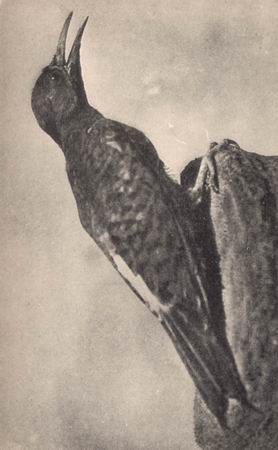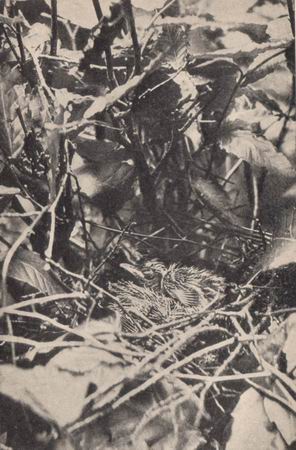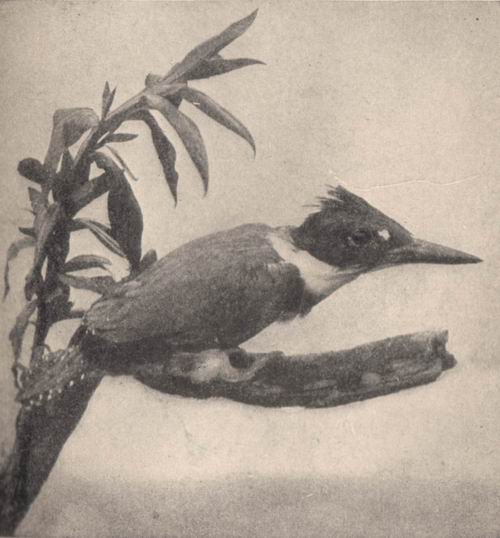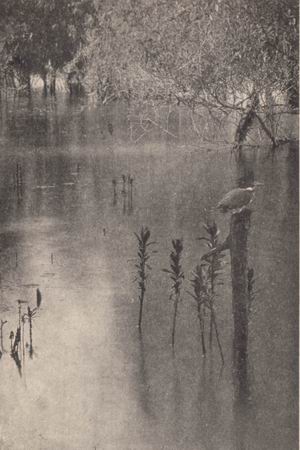|
1999-2004 (Return to Web Text-ures) |
Click Here to return to Birds Every Child Should Know Content Page Click Here to return to last Chapter |
 (HOME) |
|
1999-2004 (Return to Web Text-ures) |
Click Here to return to Birds Every Child Should Know Content Page Click Here to return to last Chapter |
 (HOME) |
|
CHAPTER XIV
CUCKOO AND KINGFISHER YELLOW-BILLED CUCKOO BLACK-BILLED CUCKOO BELTED KINGFISHER YELLOW-BILLED CUCKOO Called also: Rain Crow DO YOU own a cuckoo clock with a little bird inside that flies out of a door every hour and tells you the time? Except when it is time to go to school or to bed you are doubtless amused to hear him hiccough cuckoo, cuckoo, the mechanical notes that tell his name. Cuckoo clocks were first made in Europe where the. common species of cuckoo calls in this way, but don't imagine its American cousins do. Our yellow-billed cuckoo's unmusical, guttural notes sound something like a tree toad's rattle, kuk-kuk, kuk-kuk, kuk-kuk, kr-r-r-uck, krr-r-uck, kr-r-r-uck, kr-r-ruck, cow, cow, cow, tow! This is his complete "song," but usually one hears only a portion of it. The black-billed cuckoo's voice is softer, and its cow notes run together, otherwise their "songs " are alike. Both of our common cuckoos are slim, graceful birds about twelve inches long-longer than a robin. They are solitary creatures and glide silently among the foliage of trees and shrubbery, rarely giving you a good look at their satiny, grayish-brown backs and dull-white breasts. You may know the yellow-billed cuckoo by the yellow lower-half of his long, curved bill, his cinnamon-brown wings and the conspicuous. white thumb-nail spots on his dark tail feathers. If you were to dip your thumb in white paint, then pinch these outer quills, you would leave similar marks. Most birds will not touch the hairy, fuzzy caterpillars-very disagreeable mouthfuls, one would think. But happily cuckoos enjoy them as well as the smooth, slippery kind. "I guess they like the custard inside," said a little boy I know who had stepped on a fat caterpillar on the path. "Cuckoos might well be called caterpillar birds," wrote Florence Merriam Bailey, "for they are so given to a diet 'of the hairy caterpillars that the walls of their stomachs are actually permeated with the hairs, and a section of stomach looks like the smoothly brushed top of a gentleman's beaver hat." When you see the webs that the tent caterpillar stretches across the ends of the branches of fruit and nut trees toward the end of summer, or early autumn, watch for the cuckoo's visits. Orioles, also, tear open the webs to get at the wiggling morsels inside, but they leave dead and mutilated remains behind them, showing that their appetite for web worms is less keen than that of the cuckoos, who eat them up clean. Fortunately the caterpillar of the terribly destructive gypsy moth is another favourite dainty. Perhaps you have heard that the cuckoo, like the naughty cowbird, builds no nest and lays its eggs in other birds' cradles? This is true only of the European cuckoo. Its American cousin makes a poor apology for a nest, it is true, merely a loose bundle or platform of sticks, as flimsily put together as a dove's nest. The greenish-blue eggs or the naked babies must certainly fall through, one would think. Still it is all the cuckoos' own, and they are proud of it. But so sensitive and fearful are they when a human visitor inspects their nursery that they will usually desert it, never to return, if you touch it, so beware of peeping! When the skinny cuckoo babies are a few days old, blue pin-feathers begin to appear, and presently their bodies are stuck full of fine, sharply pointed quills like a well-stocked pin cushion. Porcupine babies you might think them now. But presto! every pin-feather suddenly fluffs out the day before the youngsters leave the nest, and they are clothed in a suit of soft feathers like their parents. In a few months young cuckoos, hatched as far north as New England and Canada or even Labrador, are strong enough to fly to Central or South America to spend the winter.  The flicker
 Two baby cuckoos on the rickety bundle of sticks that by courtesy we call a nest
BELTED KINGFISHER Called also: The Halcyon This Izaak Walton of birddom, whom you may see perched as erect as a fish hawk on a snag in the lake, creek or river, or on a dead limb projecting over the water, on the lookout for minnows, chub, red fins, samlets or any other small fry that swims past, is as expert as any fisherman you are ever likely to know. Sharp eyes are necessary to see a little fish where sunbeams dance on the ripples and the refracted light plays queer tricks with one's vision. Once a victim is sighted, how swiftly the lone fisherman dives through the air and water after it, and how accurately he strikes its death-blow behind the gills! If the fish be large and lusty it may be necessary to carry it to the snag and give it a few sharp knocks with his long powerful bill to end its struggles. These are soon over, but the kingfisher's have only begun. See him gag and writhe as he swallows his dinner, head first, and then, regretting his haste, brings it up again to try a wider avenue down his throat! Somebody shot a kingfisher which had tried to swallow so large a fish that the tail was sticking out of his mouth, while its head was safely stored below in the bird's stomach. After the meat digests, the indigestible skin, bones, and scales of the fish are thrown up without the least nausea. A certain part of a favourite lake or stream this fisherman patrols with a sense of ownership and rarely leaves it. Alone, but self-satisfied, he clatters up and down his beat as a policeman, going his rounds, might sound his rattle from time to time. The rattle-headed bird knows every pool where minnows play, every projection along the bank where a fish might hide, and is ever on the alert, not only to catch a dinner, but to escape from the sight of the child who intrudes on his domain and wants to "know" him. You cannot mistake this big, chunky bird, fully a foot long, with grayish-blue upper parts, the long, strong wings and short, square tail dotted in broken bars of white, and with a heavy, bluish band across his white breast. His mate and children wear rusty bands instead of blue. The crested feathers on top of his big, powerful head reach backward to the nape like an Indian chief's feather bonnet, and give him distinction. Under his thick, oily plumage, as waterproof as a duck's, he wears a suit of down underclothing. No doubt you have heard that all birds are descended from reptile ancestors; that feathers are but modified scales, and that a bird's song is but the glorified hiss of the serpent. Then the kingfisher and the bank swallow retain at least one ancient custom of their ancestors, for they still place their eggs in the ground. The lone fisherman chooses a mate early in the spring and, with her help, he tunnels a hole in a bank next a good fishing ground. A minnow pool furnishes the most-approved baby food. Perhaps the mates will work two or three weeks before they have tunnelled far enough to suit them and made a spacious nursery at the end of the long hall. Usually from five to eight white eggs are laid about six feet from the entrance on a bundle of grass, or perhaps on a heap of ejected fish bones and refuse. While his queen broods, the devoted kingfisher brings her the best of his catch. At first their babies are as bare and skinny as their cuckoo relatives. When the father or mother bird flies up stream with a fish for them, giving a rattling call instead of ringing a dinner bell, all the hungry youngsters rush forward to the mouth of the tunnel; but only one can be satisfied each trip. Then all run backward through the inclined tunnel, like reversible steam engines, and keep tightly huddled together until the next exciting rattle is heard. Both parents are always on guard to drive off mink, rats and water snakes that are the terrors of their nursery.  Waiting for mamma and fish
 Young belted kingfisher on his favourite snag
 Kingfisher on the look-out for a dinner |